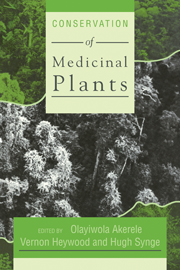Book contents
- Frontmatter
- Contents
- Contributors
- Preface
- Acknowledgements
- The Chiang Mai Declaration
- Introduction
- The Issue of Medicinal Plants
- Science, Industry and Medicinal Plants
- 6 Valuing the Biodiversity of Medicinal Plants
- 7 Economic Aspects of Exploitation of Medicinal Plants
- 8 Industry and the Conservation of Medicinal Plants
- 9 Information Systems and Databases for the Conservation of Medicinal Plants
- Techniques to Conserve Medicinal Plants
- Policies to Conserve Medicinal Plants
- Experiences from Programmes to Conserve Medicinal Plants
6 - Valuing the Biodiversity of Medicinal Plants
Published online by Cambridge University Press: 07 September 2010
- Frontmatter
- Contents
- Contributors
- Preface
- Acknowledgements
- The Chiang Mai Declaration
- Introduction
- The Issue of Medicinal Plants
- Science, Industry and Medicinal Plants
- 6 Valuing the Biodiversity of Medicinal Plants
- 7 Economic Aspects of Exploitation of Medicinal Plants
- 8 Industry and the Conservation of Medicinal Plants
- 9 Information Systems and Databases for the Conservation of Medicinal Plants
- Techniques to Conserve Medicinal Plants
- Policies to Conserve Medicinal Plants
- Experiences from Programmes to Conserve Medicinal Plants
Summary
Introduction
The preservation of biodiversity has received considerable attention over the last two decades in both the scientific community and in public policy debates. However, much of this attention in the public policy arena has centered on the domestic aspects of the problem. For example, the United States enacted a law (the Endangered Species Act) that established a policy of identifying and preserving endangered species. The international aspect of the loss of biodiversity has elicited less interest from OECD countries, although it was raised as a significant issue at the Stockholm Conference in 1972. While it has remained a widely discussed issue in scientific circles, biodiversity has not been accepted by national policy-makers as a vital global resource warranting preservation at an international level.
A primary reason for this is the considerable uncertainty surrounding the whole issue. The reasons for this uncertainty will be discussed throughout this paper, but they relate to almost every facet of the problem: from determining the size of the plant population and the magnitude of the risk of extinction, through ascertaining of the value of these resources to OECD countries and the likelihood and magnitude of adverse effects resulting from their loss, to identifying potential policies and actions that would resolve the problem. While there appeared to be considerable work on the value of biodiversity to crops, little was available on the pharmaceutical market. It was within this context that the OECD decided to undertake a study of that part of the biodiversity issue concerning medicinal plant species.
- Type
- Chapter
- Information
- Conservation of Medicinal Plants , pp. 79 - 124Publisher: Cambridge University PressPrint publication year: 1991
- 21
- Cited by



